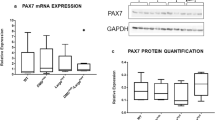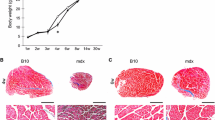Summary
Extensor digitorum longus muscles of normal mice (C57BL/10ScSn hereafter called C57) were orthotopically transplanted into dystrophin-deficient mice (mdx) and reciprocally, mdx Extensor digitorum longus muscles were transplanted into C57 mice. After an initial phase of degeneration, transplanted muscles regenerate nearly completely, as evaluated from the maximum isometric force of muscles isolated 60 days after the surgery. In other similar experiments, instead of isolating the grafted muscles, we excised the antero-external muscles of the leg, including the grafted muscle. Cryostat cross-sections at three levels along the muscles were immunostained with an anti-dystrophin antibody. No muscle cells of dystrophin-deficient muscles grafted into normal mice took the antibody except a few ‘revertant’ fibres, while all the muscle cells of the normal host were immunostained. Reciprocally, all the muscles cells of normal grafts were stained, whilst no antibody stained the cells of the surrounding muscles of the dystrophin-deficient host. These experiments show that very few if any of the myoblasts or muscle precursor cells, active during the regeneration of grafted muscle, migrate into the adjacent muscles. These results could be explained by the absence, in our work, of injuries of the grafted and adjacent host muscles epimysium and the absence of extensive inflammatory reactions. This lack of myoblast mobility suggest that when myoblast transfer is applied to muscle therapy, it will be necessary to inject myoblasts within each muscle to obtain an efficient treatment.
Similar content being viewed by others
References
BULFIELDG., SILLERW. G., WIGHTP. A. L. & MOOREK. J. (1984) X chromosome-linked muscular dystrophy (mdx) in the mouse. Proc. Natl. Acad. Sci. USA 18, 1189–92.
CARLSONB. M. (1973) The regeneration of skeletal muscle—a review. Am. J. Anat. 137, 119–50.
COULTONG. R., MORGANJ. E., PARTRIDGET. A. & SLOPERJ. C. (1988) The mdx mouse skeletal muscle myopathy: I. A histological, morphometric and biochemical investigation. Neuropathol. Appl. Neurobiol. 14, 53–70.
DIMARIOJ. X., UZMANA. & STROHMANR. C. (1991) Fiber regeneration is not persistent in dystrophic (mdx) mouse skeletal muscle. Develop. Biol. 148, 314–21.
GHINSE., COLSON-VAN SCHOORM. & MARÉCHALG. (1984) The origin of muscle stem cells in rat triceps surea regenerating after mincing. J. Muscle Res. Cell Motil. 5, 711–22.
HOFFMANE. P., HUDECKIM., ROSENBERGP., POLLINAC. & KUNKELL. M. (1988) Cell and fiber-type distribution of dystrophin. Neuron 1, 411–20.
HOFFMANE. P., MORGANJ. E., WATKINSS. C. & PARTRIDGET. A. (1990) Somatic reversion/suppression of the mouse mdx phenotype in vivo. J. Neurol. Sci. 99, 9–25.
HUARDJ., LABRECQUEC., DANSEREAUG., ROBITAILLEL. & TREMBLAYJ. P. (1991) Dystrophin expression in myotubes formed by the fusion of normal and dystrophic myoblasts. Muscle Nerve 14, 178–82.
HUGHESS. M. & BLAUH. M. (1990) Migration of myoblasts across basal lamina during skeletal muscle development. Nature 345, 350–3.
JOCKUSCHH., MEHRKEG. & FUCHTBAUERE.-M. (1983) Beating heart muscle in a skeletal muscle bed. Exp. Neurol. 81, 749–55.
KARPATIG., POULIOTY., ZUBRZYCKA-GAARNE., CAR-PENTERS., RAYP. N., WORTONR. G. & HOLLANDP. (1989) Dystrophin is expressed in mdx skeletal muscle fibers after normal myoblast implantation. Am. J. Pathol. 135, 27–32.
LAWP. K., GOODWINT. G., FANGQ., DUGGIRALAV., LARKINC., FLORENDOJ. A., KIRBYD. S., DEERINGM. B., LIH. J., CHENM., YOOT. J., CORNETTJ., LIL. M., SHIRZADA., QUINLEYT. & HOLCOMBR. L. (1992) Feasibility safety, and efficacy of myoblast transfer therapy on Duchenne muscular dystrophy boys. Cell Transplant. 1, 235–44.
LAWP. K., GOODWINGT. G., FANGQ., DEERINGM. B., DUGGIRALAV. & LARKINC. (1993) Cell transplantation as an experimental treatment for Duchenne muscular dystrophy. Cell Transplant. 2, 485–505.
MIRANDAA. F., BONILLAE., MARTUCCIG., MORAESC. T., HAYSA. P. & DIMAUROS. (1988) Immunocytochemical study of dystrophin in muscle cultures from patients with Duchenne muscular dystrophy and unaffected control patients. Am. J. Pathol. 132, 410–16.
MOENSP., PARTRIDGET. A., MORGANJ. E., BECKERS-BLEUKXG. & MARÉCHALG. (1992) Regeneration after free muscle grafting in normal and dystrophic (mdx) mice. J. Neurol. Sci. 111, 209–13.
MORGANJ. E., COULTONG. R. & PARTRIDGET. A. (1987) Muscle precursor cells invade and repopulate freezekilled muscles. J. Muscle Res. Cell Motil. 8, 386–96.
MORGANJ. E., COULTONG. R. & PARTRIDGET. A. (1989) mdx muscle grafts retain the mdx phenotype in normal hosts. Muscle Nerve 12, 401–9.
MORGANJ. E., PAGELC. N., SHERRATTT. & PARTRIDGET. A. (1993) Long-term persistence and migration of myogenic cells injected into pre-irradiated muscles of mdx mice. J. Neurol. Sci. 115, 191–200.
PARTRIDGET. A. & SLOPERJ. C. (1977) A host contribution to the regeneration of muscle grafts. J. Neurol. Sci. 33, 425–35.
PARTRIDGET. A., GROUNDM. & SLOPERJ. C. (1978) Evidence of fusion between host and donor myoblasts in skeletal muscle grafts. Nature 273, 306–8.
PARTRIDGET. A., MORGANJ. E., COULTONG. R., HOFF-MANE. P. & KUNKELL. M. (1989) Conversion of mdx myofibres from dystrophin-negative to-positive by injection of normal myoblasts. Nature 337, 176–9.
PHILLIPSG. D., HOFFMANJ. R. & KNIGHTOND. R. (1990) Migration of myogenic cells in the rat extensor digitorum longus muscle studied with a split autograft model. Cell Tissue Res. 262, 81–8.
ROBERTSONT. A., MALEYM. A. L., GROUNDSM. D. & PAPADIMITRIOUJ. M. (1993) The role of macrophages in skeletal muscle regeneration with particular reference to chemotaxis. Exp. Cell Res. 207, 321–31.
SCHULTZE., JARYSZAKD. L., GIBSONM. C. & ALBRIGHTD. J. (1986) Absence of exogenous satellite cell contribution to regeneration of frozen skeletal muscle. J. Muscle Res. Cell Motil. 7, 361–7.
TANAKAH., IKEYAK. & OZAWAE. (1990) Difference in the expression pattern of dystrophin on the surface membrane between the skeletal and cardiac muscles of mdx carrier mice. Histochem. 93, 447–52.
TREMBLAYJ. P., MALOUINF., ROYR., HUARDJ., BOUCHARDJ. P., SATOHA. & RICHARDSC. L. (1993) Results of a triple blind clinical study of myoblast transplantations without immunosuppressive treatment in young boys with Duchenne muscular dystrophy. Cell Transplant. 2, 99–112.
VENKATASUBRAMANIANK. & SOLURSHM. (1984) Chemotactic behaviour of myoblasts. Dev. Biol. 104, 428–33.
WATKINSS. E. P. H., SLAYTERH. & KUNKELL. M. (1989) Dystrophin distribution in heterozygote mdx mice. Muscle Nerve 12, 861–8.
WATTD. J., PARTRIDGET. A. & SLOPERJ. C. (1981) Cyclosporin A as a Means of preventing rejection of skeletal muscle allografts in mice. Transplantation 31, 266–71.
WATTD. J., MORGANJ. E., CLIFFORDM. A. & PARTRIDGET. A. (1987) The movement of muscle precursor cells between adjacent regenerating muscles in the mouse. Anat. Embryol. 175, 527–36.
WATTD. J., KARASINSKIJ. & MOSSJ. (1994) Migration of muscle cells. Nature 368, 406–7.
WATTD. J., KARASINSKIJ. & ENGLANDM. A. (1993) Migration of lacZ positive cells from the tibialis anterior to the extensor digitorum longus muscle of the X-linked muscular dystrophic (mdx) mouse. J. Muscle Res. Cell Motil. 14, 121–32.
Author information
Authors and Affiliations
Rights and permissions
About this article
Cite this article
Moens, P.D.J., Colson Van-Schoor, M. & Maréchal, G. Lack of myoblasts migration between transplanted and host muscles of mdx and normal mice. J Muscle Res Cell Motil 17, 37–43 (1996). https://doi.org/10.1007/BF00140322
Received:
Revised:
Accepted:
Issue Date:
DOI: https://doi.org/10.1007/BF00140322




